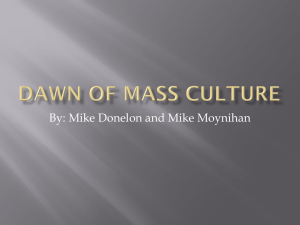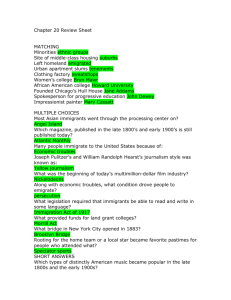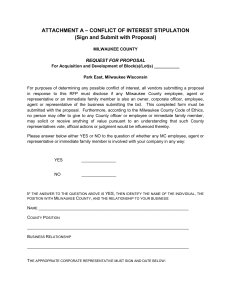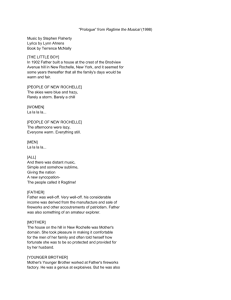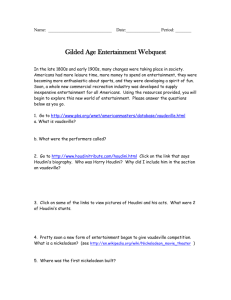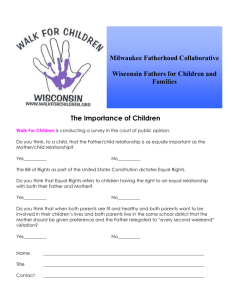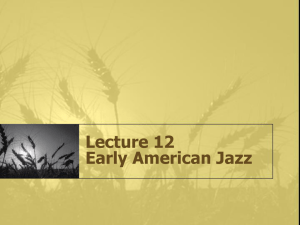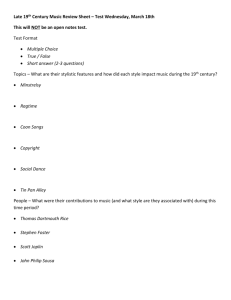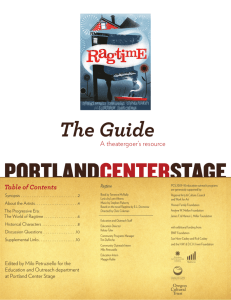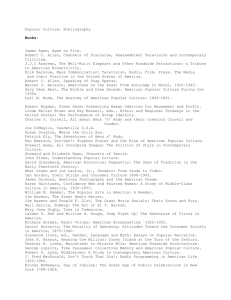SEPTEMBER 17 – OCTOBER 27
advertisement
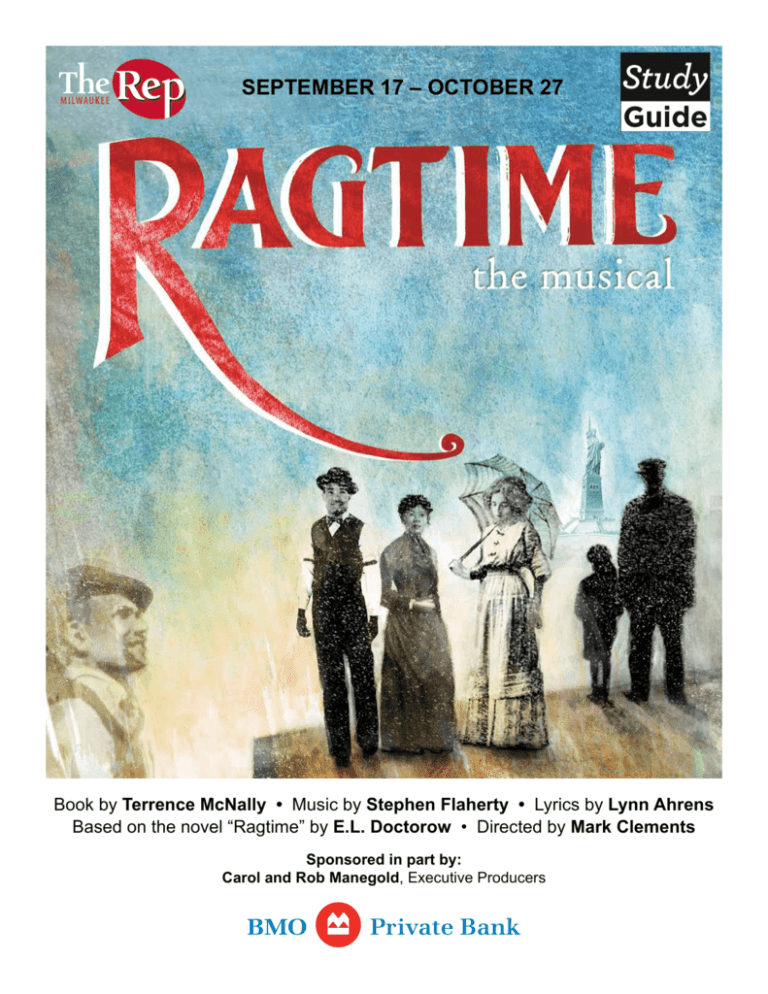
SEPTEMBER 17 – OCTOBER 27 Book by Terrence McNally • Music by Stephen Flaherty • Lyrics by Lynn Ahrens Based on the novel “Ragtime” by E.L. Doctorow • Directed by Mark Clements Sponsored in part by: Carol and Rob Manegold, Executive Producers Milwaukee Repertory Theater presents Ragtime STUDY GUIDE • Study Guide written by Lindsey Hoel-Neds Education Associate • Study Guide edited by Leda Hoffmann Literary Coordinator Jenny Kostreva Education Director September 17 – October 27 QUADRACCI POWERHOUSE Lisa Fulton Director of Marketing & Communications Music by Stephen Flaherty • Book by Terrence McNally Lyrics by Lynn Ahrens Based on the novel “Ragtime” by E.L. Doctorow Directed by Mark Clements Graphic Design by Shawn Kavon MARK’S TAKE “With my arrival, The Rep instituted a tradition of producing powerful, thought-provoking musicals in the Quadracci Powerhouse. This season’s offering is an extremely moving and uplifting adaptation of E.L. Doctorow’s well-loved and epic novel, Ragtime. This musical is guaranteed to live in your memory forever.” -Mark Clements, Artistic Director Mark Clements Artistic Director Chad Bauman Managing Director Milwaukee Repertory Theater 108 E. Wells Street Milwaukee, WI • 53202 Tickets: 414-224-9490 www.MilwaukeeRep.com TABLE OF CONTENTS Synopsis ....................................................................................................... 3 Creators and Creative Team of Ragtime ..................................................... 5 The Characters of Ragtime ........................................................................... 6 Entertainments at the Turn of the Century .................................................... 8 Innovations at the Turn of the Century ......................................................... 9 Social and Political Issues in the Progressive Era ....................................... 10 The Progressive Era in Wisconsin ............................................................... 12 An Interview with Costume Designer, Alex Tecoma ..................................... 13 Juggling the Demands of Ragtime ............................................................... 15 2 • Ragtime SYNOPSIS This synopsis of the play contains spoilers. Act I Ragtime opens at the turn of the 20th century: a time of progress, a time of excitement, a time of “a distant music changing the tune, changing the time.” Lawrence Textile Workers’ Strike, 1912. police find the baby’s mother, Sarah, and Mother invites the two to live with her family. Eventually Coalhouse Walker, the baby’s father, comes to court Sarah and after months of charming the New Rochelle family with his music, Sarah agrees to marry him. Coalhouse’s arrival disturbs the sheltered peace of New Rochelle; a black man in a Model T is a new and shocking addition to the white community. Fire Chief Willie Conklin and his men harass Coalhouse when he tries to pass down the street. The arrival of Coalhouse and Sarah also changes the dynamic for the New Rochelle family, and Father does not know how to cope with his changing family and changing world upon his return. After Sarah and Coalhouse are finally united, the firemen again harass the couple, and when Coalhouse leaves to find a policeman, the firemen vandalize his car. Unable to find justice through the police and the courts, Coalhouse vows not to marry Sarah until justice is served. The lives of three different families and worlds collide. These families are an upper-middle-class family from New Rochelle (Mother, Father, Little Boy, Younger Brother, and Grandfather), a couple from Harlem (Coalhouse Walker, Jr. and Sarah), and a Latvian immigrant and his daughter (Tateh and Little Girl). Ragtime opens with the intersection of these people’s lives and those of prominent historical characters such as J.P. Morgan, the financier; Evelyn Nesbit, the famous beauty; and Harry Houdini, the escape artist and illusionist. After Father departs for an expedition to the North Pole with Admiral Robert Peary, Mother finds an AfricanAmerican baby in her backyard while gardening. The Immigrants Arriving at Ellis Island, 1903. Early Vaudeville Advertisement. Younger Brother also experiences unrest during this period. He fosters a serious infatuation with Evelyn Nesbit, and one night after her vaudeville show, she kisses him as a publicity stunt. Younger Brother is heartbroken by the realization that she will not be with him. In his search for love and purpose, he finds himself pondering the larger ideas of life, and ends up at a labor rally led by activist Emma Goldman. Meanwhile, Tateh and the Little Girl arrive at Ellis Island after a long journey to America. They find life in New York difficult, and Tateh cannot make a living through his art, the creation of paper silhouettes. After a man offers to buy the Little Girl, Tateh decides that they must leave New York in search of a better life. Tateh finds a factory www.MilwaukeeRep.com • page 3 job working 64 hours a week for minimal pay in Lawrence, Massachusetts. There is a strike, and Tateh tries to send the Little Girl away for her safety, but he cannot bear to hear her cries and accompanies her to Philadelphia. He comforts her by giving her a flipbook he has created, which he later sells to the train conductor, jump-starting his future career. After his rampage in New Rochelle, Coalhouse retreats to the relative safety of Harlem. Younger Brother arrives full of new ideas and passion, and becomes a part of Coalhouse’s gang due to his expertise in creating explosives. Coalhouse and his men take over the Morgan Library and threaten to blow it up if the District Attorney does not meet their demands. The act closes with Sarah at a political rally where she tries to appeal to the Vice-Presidential candidate for help with Coalhouse’s case. Police, who think she is an assassin, kill her. Act II Act II opens with New Rochelle in chaos: Coalhouse has killed three firemen and burned the firehouse, demanding justice and the return of his Model T. Mother decides to take care of Sarah’s child permanently, against the wishes of the child welfare officials and Father. After the pressure builds in the New Rochelle home and Younger Brother angrily leaves the house, Father decides that the best way to cope is to take the Little Boy to a baseball game and the family for an extended stay in Atlantic City. Upon their arrival in Atlantic City, the family sees a movie being filmed by Baron Askenazy, later revealed to be Tateh, who has turned his flipbooks into a successful film career. The Little Girl and the Little Boy become friends, and in turn, Tateh and Mother form a bond over their children’s relationship. Steel Pier, Atlantic City, 1910. 4 • Ragtime Morgan Library, built in 1906. Both Father and Booker T. Washington arrive at the library to convince Coalhouse to give himself up for the sake of his men and his son. Coalhouse finally sends all of his men out to safety. After a heart-to-heart with Father about his child, Coalhouse walks out of the library and the police kill him on sight. The musical closes with an epilogue: Father dies aboard the Lusitania, Younger Brother joins the revolutionary Emiliano Zapata in Mexico, and Mother weds Tateh after Father’s death. They raise the Little Boy, the Little Girl, and Coalhouse Walker III together as a family. Creators & Creative Team of Ragtime E.L. Doctorow (Author of the Novel) The musical Ragtime is an adaptation of the novel of the same name, written by E.L. Doctorow and published in 1975. The novel received much critical acclaim and Time and the Modern Library listed it as one of the top 100 English-language novels of the 20th century. Doctorow is known for his historical fiction, his unique and sometimes experimental literary style, and his ability to incorporate contemporary values and ideas into his discussions of past events. Some of his other notable works include The Book of Daniel (1971), Billy Bathgate (1989), and City of God (2000). Terrence McNally (Book) Terrence McNally is an accomplished writer of television, plays, and books for musicals. McNally has won four Tony awards for his writing of the book for Kiss of the Spider Woman (1993), and for his adaptation of Doctorow’s novel Ragtime (1997), as well as for his plays Love! Valor! Compassion! (1995), and Master Class (1996). Other notable works include: Frankie and Johnny in the Clair de Lune, Andre’s Mother (television mini-series), and the controversial play, Corpus Christi. McNally’s newest play, Mothers and Sons, premiered this June at Bucks County Playhouse. Lynn Ahrens and Stephen Flaherty (Music and Lyrics) Ahrens and Flaherty have worked together since the early 1980s, and their first musical, Lucky Stiff, premiered Off-Broadway in 1988. Their work on Ragtime garnered the attention of audiences and critics alike, and they went on to win the Tony Award for Best Score, a Drama Desk award, and two Grammy nominations for the show. Other notable collaborations include: Seussical, Once on this Island, and the songs for the animated film, Anastasia. Milwaukee Rep’s Creative Team Director Musical Direction Choreographer Scenic Designer Costume Designer Lighting Designer Sound Designer Dialect Coach Associate Sound Designer Dance Captain Fight Choreographer Casting Directors New York Casting Assistant Director Rehearsal Pianist Stage Manager Assistant Stage Managers Stage Manager Apprentice Stage Management Intern Mark Clements Dan Kazemi± Stephen Mear Todd Edward Ivins± Alexander B. Tecoma Jeff Nellis± John Tanner± Jill Walmsley Zager Henry Lewis II Elizabeth Earley Kyle Curry Sandy Ernst & JC Clementz Stephanie Klapper Emily Penick Paul Helm Laura F. Wendt * Sarah Hoffmann* Kimberly Ann McCann* Kaitlin Kitzmiller Kimberly Carolus ± Rep Associate Artist *Member of Actors’ Equity Association the Union of Professional Actors and Stage Managers in the United States. www.MilwaukeeRep.com • page 5 CHARACTERS OF RAGTIME NEW ROCHELLE Grandfather Willie Conklin Jonathan Gillard Daly Gerard Neugent harasses Coalhouse Father married Mother Carmen Cusack David Hess Younger Brother Michael Doherty becomes part of the Coalhouse gang Little Boy Tyler Johnson/ Luke Brotherhood later married takes them into her home Sarah Coalhouse Walker Jr. Jessie Hooker Gavin Gregory Coalhouse Walker III Tateh Josh Landay NEW YORK CITY 6 • Ragtime Little Girl Georgia Pink/ Mallorey Wallace Sarah’s friend Bethany Thomas HARLEM Historical Figures Featured in Ragtime Harry Houdini (Sam Strasfeld) – A famous illusionist and stunt performer, Harry Houdini was born in Hungary and then grew up in Appleton, Wisconsin, and New York City. Houdini is famous in both the U.S. and Europe for his daring escape acts. Emma Goldman (Melissa Joy Hart) – Emma Goldman was an activist, anarchist, and feminist. Goldman gave fiery speeches and wrote controversial books, articles, and pamphlets about the issues she most supported. She was never afraid to be arrested for her actions or her words; eventually, Goldman’s activism led to her deportation to Russia. 1900s. Nesbit married the wealthy Harry K. Thaw, but Thaw’s anger about Nesbit’s affair with architect Stanford White led him to murder White. The ensuing trial was a sensation, and Nesbit’s fame rose. Nesbit modeled, acted, and performed in a variety of vaudeville acts throughout her career. Booker T. Washington (Carl Clemons Hopkins) – Booker T. Washington was an educator, orator, and activist. Washington was born a slave, and later worked to improve race relations in the South and across the United States. In 1881, he founded the Tuskegee Institute, one of the most prestigious Historically Black Colleges in the United States. J.P. Morgan (Jonathan Gillard Daly) – Arguably the most powerful banker and businessman in America at the turn of the 20th century, Morgan was shrewd and efficient, but many argued that his methods disregarded the needs of people outside of the wealthy elite. Henry Ford (James Patterson) – Henry Ford invented his first car in 1896, and released the Model T in 1908. Ford’s assembly line production methods revolutionized the manufacturing industry. Admiral Robert Peary (Steve Watts) – Determined to reach the North Pole, Admiral Robert Peary was the first to do so in 1909 with the assistance of Inuit guides. Matthew Henson (Gabriel Mudd) – Henson accompanied Peary on many expeditions over the years as his assistant. Out of all of the members of Peary’s exploration group, only Henson and the Admiral arrived at the North Pole with their guides. Evelyn Nesbit (Kelley Faulkner) – Evelyn Nesbit inspired the Gibson Girl ideal, popular in the early www.MilwaukeeRep.com • page 7 ENTERTAINMENTS at the Turn of the Century Ragtime Music Ragtime, a distinctly American musical style with a syncopated rhythm, gained popularity at the end of the 1800s. Ragtime evolved out of AfricanAmerican music, but quickly became a style of music composed by and loved by a wider population. Ragtime Ragtime sheet music, popular was everywhere by the musicians and composers. early 1900s—from sheet music to piano rolls to ragtime piano playing contests, the style was the biggest musical fad of the day. Ragtime music characterized an era of change with a fast moving, catchy sound that combined marches with the rhythms of African music. Through the slightly off-meter rhythm of syncopation, ragtime moved along at a pace unlike any other popular music of the time. Controversy met the rise of ragtime music, as it has many other musical styles. A musician’s convention wanted to officially dub ragtime ‘unmusical rot’. Some were also concerned with the moral decay that ragtime music’s jumpy rhythms might bring to America’s youth. Regardless of this controversy, ragtime music has persisted for over one hundred years, and has experienced several revivals of its popularity throughout the last century. Vaudeville Eddie Garland (ventriloquist) and cast. 8 • Ragtime From the 1880s to the 1920s, vaudeville was the most popular entertainment in America. Featuring comedians, singers, plate-spinners, ventriloquists, dancers, musicians, acrobats, animal trainers, and many other performers, vaudeville was the quintessential variety show. Successful vaudeville acts toured over 40 weeks a year, and they often had more than one show in a day. Performers suffered from poor working conditions, but made respectable pay compared to many other jobs. Vaudeville’s 50-year reign over the American entertainment scene ended in the 1930s with the Great Depression and the rising popularity of movies. The Beginnings of Film Life shines from the shadow screen Comical, yet infinitely true. People love to see what people do, Here where everyone is someone new! “Buffalo Nickel Photoplay, Inc.,” Ragtime The first films were short snippets of everyday occurrences like a horse running or a train pulling out of a station. Starting in the 1880s and 1890s, these early films fascinated people with the ability to capture the reality of day-to-day life. Soon, the possibilities of film expanded to include plot lines and actors, and audiences flocked to movie houses. Seeing a film became prime entertainment throughout the country, and from 1906 onward, the production and exhibition of films grew worldwide. Atlantic City, New Jersey Atlantic City built a boardwalk as a tourist attraction in 1870, and the city later expanded the boardwalk due to its popularity. By the turn of the century, the Atlantic City Boardwalk was a booming vacation spot, and new hotels and businesses sprouted up everywhere. Vaudeville Atlantic City Beach, 1902. acts and other entertainers flocked to “The World’s Playground” to perform and hone their acts. Tourists from all over the United States and the world came to Atlantic City to enjoy the beach, the entertainment, and the atmosphere. INNOVATIONS at the Turn of the Century The age of Ragtime was an era of change, and much of that change came from innovations in technology and industry. The musical Ragtime includes one of the greatest inventors of his day, Henry Ford. Ford was only one of many great innovators; many technologies we take for granted today were created in the early 1900s. “Mass production will sweep the nation, a simple notion, the world’s reward.” “Henry Ford,” Ragtime Turn of the Century Innovation in Wisconsin While Henry Ford changed the world with his assembly line and Model T, companies around Wisconsin also made an impact in the world of technology. • In 1882, an Appleton power plant produced the first electricity offered for sale anywhere in the world. • An automobile company in Kenosha, started in 1900, became the largest producer of automobiles outside of Detroit by 1916. • In 1903, Milwaukee’s Harley Davidson produced its first motorcycles for sale to the public. • The Oneida Street Power Plant, constructed from 1898 to 1900, now houses The Rep, and was the first central power plant to successfully operate on pulverized coal. 1912 Ford Model T. The Model T and the Assembly Line The Model T was an automobile produced by the Ford Motor Company from 1908 to 1927. Ford built over 15 million Model Ts, and due to new assembly line production methods, the cost of the automobile became much more reasonable for the American public. At one point, the Model T comprised 40% of all automobile sales in the United States. The Airplane In 1903, Orville and Wilbur Wright were the first people to successfully fly a self-propelled, heavier than air aircraft. Inspired by the glider flights of a German engineer, and armed with their skills in building bicycles, the brothers set out to design several versions of different aircraft. After a number of hits and misses with gliders, the brothers finally successfully piloted a propelled aircraft in December of 1903. Oneida Street Power Plant. The Radio Receiver In 1901, Guglielmo Marconi broadcasted the first transatlantic radio signal, allowing for safer maritime travel and further communication worldwide. Movies The first machine patented in the United States to show moving pictures was called a zoopraxiscope, which allowed pictures to be watched through a slit in the mechanism, but was a far cry from what we know today as film. The first motion picture cameras were invented in the late 1890s, and soon watching short films became a source of entertainment for people around the world. www.MilwaukeeRep.com • page 9 SOCIAL AND POLITICAL ISSUES in the Progressive Era (1895-1925) Ragtime takes place in the midst of the Progressive Era in America, a general term used for a series of social and political responses to the problems created through industrialization, urbanization, and different areas of American life. Women’s Movement Labor Movement The Industrial Revolution brought great progress to the U.S., but also many new problems for the laboring class. Overcrowding, child labor, poor working conditions, sweatshops, and excessively long work hours were all issues that arose in the age of industrialization. As conditions worsened, but the economy improved, workers started to organize through labor unions. The first large union was the Order of the Knights of Labor, founded in 1869. Labor organizers hoped to eventually unionize all workers, but that was an uphill battle. Unorganized workers held many strikes and protests in the second half of the 19th century, and these protests brought many changes to labor laws: the enactment of minimum wages, child labor regulations, and maximum hours per day. The advent of the American labor movement met much opposition; factory owners often called in police or punished participants who participated in labor protests. Despite the consequences, the American labor movement continued, with many labor victories and expansion of membership in the first several decades of the 20th century. A Suffragist Parade, New York, 1912. By 1900, 20% of American women were employed outside of the home. Unfortunately, many women held low-paying jobs with no hope for advancement. As more women found themselves with roles outside of being mothers and wives, they founded organizations to deal with issues ranging from suffrage to the right to vote to working conditions. While the suffrage movement began in the mid-1800s, it gained steam during the Progressive era, with more women becoming involved as the new century arrived. In June of 1919, Wisconsin was the first state to ratify the 19th amendment, and women secured the right to vote nationwide in 1920. Girls weaving, Evansville, Indiana, 1908. 10 • Ragtime Race Relations and the Immigrant Experience The era of Ragtime was a troubled time in the history of race relations in America. Large numbers of immigrants entered the country and racism towards AfricanAmericans continued after the abolition of slavery. In 1896, the Plessy vs. Ferguson case legitimized the idea of “separate but equal,” leading to the continuance of restrictive and discriminatory Jim Crow laws throughout much of the United States. The laws varied by state, but many of the regulations centered on separating white facilities from facilities for people of color, which led to the segregation of most public institutions. Socialist rally in Union Square, 1912. New Political Forces Ponce de Leon Park, Atlanta, early 1900s. The sign says, “Colored people admitted as servants only.” While discrimination towards blacks was the most insidious example of racism in America, immigrants also faced bigotry and hardship. Between 1870 and 1900, over 12 million immigrants came to the United States, many through New York, which was then known as, “The Golden Door.” In cities with high immigrant populations, newcomers to the U.S. were often stereotyped, harassed, and sometimes met with violence. Finding work that paid a living wage was especially hard for immigrants, and many people faced discrimination in the workplace and on the streets. Tenement housing was the only option for many immigrants, and the poor living conditions were often unbearable. The obstacles to equality were huge, but individuals including Booker T. Washington and W.E.B. DuBois advocated for civil rights. For immigrants, the settlement house movement and other social programs helped them find their way in a new country. At the turn of the 20th century, several new political movements gained support in the United States: the Progressive Movement and the Socialist Movement. Both political parties sought social change in the form of reforming education, improving public works, supporting workers, and generally finding ways to help the common people. The Progressives were an offshoot of the Republican Party, while the Socialists chose to disassociate themselves with the dominant political parties. Both groups found footholds in the political arena, and social change came from some of the actions of these groups. Anarchism also gained some political clout during this time, due to activists such as Emma Goldman, who is a featured character in Ragtime. The Progressives and Socialists advocated more government involvement, but anarchists thought that a society without government based on social cooperation was the ideal. While their tactics and philosophies seemed extreme, they shared goals of social change with the more accepted Progressive and Socialist movements. “Yes, the wheels are turning for us girl, and the times are starting to roll. Any man can get where he wants to if he’s got some fire in his soul. We’ll see justice, Sarah, and plenty of men will stand up and give us our due. “ “Wheels of a Dream,” Ragtime www.MilwaukeeRep.com • page 11 The Progressive Era in Wisconsin Mayor, Emil Seidel, in 1910. The local government improved conditions for the common people through new sanitation systems, municipally owned water and power, community parks, and school reform. Although they fought for many of the same goals, and Socialists and Progressives agreed not to run candidates against each other in Milwaukee elections, there was still contention between the two groups based on their differing ideologies. Immigration in Milwaukee Robert M. La Follette. The Progressive movement started in Wisconsin with Robert M. La Follette, who served as governor and later as a U.S. Senator. “Progressive” Republicans considered the business of government to not be business at all, but service to the common people. Progressives enlisted faculty from the University of Wisconsin to advise them; this “Wisconsin Idea” brought together politics and academics in a new way that sought to create change on many levels. The Progressives in Wisconsin enacted new voting laws, broke up monopolies, preserved state forests and began the system of state parks, instituted one of the nation’s first worker’s compensation programs, passed laws to regulate factory safety, regulated railroads, established a state income tax, and limited work hours for women and children. In Milwaukee, the major political force was not the Progressives, but was the rising Socialist contingent in the city. Milwaukee’s Victor Berger was a strong Socialist advocate and activist, and Berger’s words moved many in Milwaukee to support the party and elect the nation’s first Socialist 12 • Ragtime Immigrants have long been an important part of Milwaukee’s cultural fabric. While the neighborhoods have changed over time, the diversity of Milwaukee’s ethnic cultures continues to be a big part of the city’s identity. The earliest European immigrants to come to Milwaukee in large numbers were Germans in the late 1830s. In the year 2000, 38% of Milwaukeeans claimed at least some German ancestry. Later in the 1800s, Irish, Italian, and Polish people came to Milwaukee and contributed their own cultural heritage to the city’s social fabric. African-Americans have been a part of Milwaukee since before the city was founded, but the numbers of AfricanAmericans in Milwaukee increased exponentially from 19101930. Other groups that later contributed to Milwaukee’s distinct cultural composition are the many cultures of the Latino community and the Hmong community. For more information on Milwaukee’s history, check out the following resources: • The Making of Milwaukee, www.themakingofmilwaukee.com • Milwaukee County Historical Society, www.milwaukeehistory.net • Wisconsin Historical Society, www.wisconsinhistory.org • Cream City Chronicles: Stories of Milwaukee’s Past by John Gurda Victor Berger. An Interview with Alex Tecoma Ragtime costume designer Costume Designer Alex Tecoma sat down with Education Assistant Lindsey Hoel-Neds to talk a little bit about the costumes of Ragtime. Tecoma is the Senior Draper in The Rep’s costume shop and has recently designed Assassins and Next to Normal for The Rep. How many costumes are being used in this production? More than one hundred. How many have you pulled from stock, versus renting, versus constructing? I would say we are constructing probably ten percent and probably sixty percent came out of our stock and the rest is from American Players Theater, the Skylight and a few other places. How do you go about researching a period show? easier and easier because it is a priority of theirs before all the paper rots to get everything digitized. So a lot of the research came from the online collections of the New York Public Library and the Library of Congress. Surprisingly, I did not have to go very far beyond that. I also like documentaries. PBS did this wonderful American Experience on Henry Ford – from that we were able to get a lot of visuals for the factory workers. Which piece that you are constructing is the most labor intensive? That will either be Coalhouse’s suit or Mother’s blouse in Atlantic City. The blouse is going to be really time consuming because it is fine old heirloom sewing with lace. It is really tricky and the fabrics are delicate. That is probably the most labor intensive, but in terms of time, it always takes longer to make a suit, but the fabrics are a little more forgiving than lace and silk. I did most of my research for Ragtime online. And with most libraries digitizing their collections it has become easier and Costume renderings for Tateh, Little Girl, Mother, and Little Boy. www.MilwaukeeRep.com • page 13 Costume renderings for Evelyn, Coalhouse, Younger Brother, and Father. Are there any special things that are going to distinguish particular characters? not found any photographs of her performing before 1910, so her costumes are based on posters of shows, and an actress named Gaby Deslys who was Harry Selfridge’s mistress in England. I think it is pretty obvious when you see the characters on stage who is from what group. The Harlem people are all going to be in a warmer palette: reds, oranges, and purples, and the people of New Rochelle will be a bit paler and the immigrants will be in darker clothes. Texture also defines groups, because the rich people in New Rochelle are going to be shinier. Is there anything else that is special or unique about the costumes for this particular production? Many wigs and hairpieces will be used for the show, right? Yes, that just makes it easier for the actors, so they do not have to worry about doing their hair every night. With the real people that are characters in the show, did you make a particular effort to replicate things that you saw them wearing in your research? Absolutely. J.P. Morgan has a very distinct look, Henry Ford has a distinct look, so yes. Even with Evelyn Nesbit, I have 14 • Ragtime Yes, in the Atlantic City scenes, when they were originally done on Broadway, the men and women were in really fancy clothes. This production is new because we are doing all of them in bathing suits and beach attire. That is not really how it is traditionally done, so we are doing a little take on that. The idea came after seeing research of pictures of people in Atlantic City. When we were deciding what the vacationers look like, we looked at photos and said, “Oh, of course they are swimming, they are on the beach. Why would they be wearing anything else?” So, that is exciting, that is a new thing no one else has done with this production, I hope. Juggling the Demands of Ragtime Ragtime is the largest production ever seen on the Quadracci Powerhouse stage. That means a huge job for Stage Manager Laura Wendt and her team: “It certainly takes a team. It takes the ability to be flexible and forward-thinking. Stage Management tries to approach all plays by dividing up our attention to have primary and secondary focuses. My primary focus as the Stage Manager is overseeing the whole team as well as the logistics of the schedule. My assistants each focus on a different department. So two people are focusing on props and scenery, including transitions and prop tracking and presets. Another one is focusing on costumes and costume tracking and quick changes and costume presets. This allows everyone to keep their eye on the entire production but have a focus that becomes their specialty.” Ragtime artists include: 20 Equity Actors 5 Kids 11 Acting Interns 9 Band Members 5 IATSE Crew Members 1 Assistant Stagehand 1 Electrics Intern on the Spotlight 4 Wardrobe Staff 5 Stage Managers in rehearsal and 2 to run the show And a village of designers and support staff! Ragtime Cast in Rehearsal. Photo by Kaitlin Schlick. During the show, the Stage Manager calls all of the cues that signal the technicians to move the scenery, run a sound cue, or change the lighting. The Rep’s production of Ragtime integrates recorded tracks with the live band to create a large orchestral sound. The coordination of this means that the Musical Director will have a separate piano pedal that runs the computer recorded tracks. Once the play is open, the director hands all of the responsibility of running the show over to the stage management team. During the run of the show, the team is completely responsible for keeping the performances in line with the director’s vision. Ragtime Cast in Rehearsal. Photo by Kaitlin Schlick. www.MilwaukeeRep.com • page 15 VISITING THE REP Milwaukee Repertory Theater. Milwaukee Repertory Theater’s Patty and Jay Baker Theater Complex is located in the Milwaukee Center, downtown at the corner of Wells and Water Streets. The building was formerly the home of doors. The Quadracci Powerhouse is located on the second level. THEATER ETIQUETTE Attending the theater will be a positive experience for everyone if you observe a few simple courtesies: • Turn off and put away all electronic devices prior to entering the theater. • Taking photographs and video recording in the theater is prohibited. • Do not place your feet on the seat in front of you. • The actors onstage can see and hear the audience just as well as the audience can see and hear them. Please refrain from talking or moving around during the performance as it can be distracting to the actors, as well as to other audience members. • Feel free to respond to the action of the play through appropriate laughter and applause. The actors enjoy this type of communication the audience! • Have fun! Attending theater should be an enjoyable experience. CONNECT WITH US ONLINE: Like us on Facebook and follow us on Twitter @MilwRep to hear about the latest from news, special offers, and happenings at The Rep! MILWAUKEE REP EDUCATION DEPARTMENT The Education Department offers backstage tours, pre- and post-show workshops, and classroom residencies. Contact Us: For questions or to schedule a workshop, please contact: Milwaukee Repertory Theater Jenny Kostreva, Education Director Education Department 414-290-5370 • jkostreva@milwaukeerep.com 108 E. Wells Street Neal Easterling, Education Associate Milwaukee, WI 53202 414-290-5398 • neasterling@milwaukeerep.com www.MilwaukeeRep.com Lindsey Hoel-Neds, Education Assistant 414-224-9490 414-290-5393 • lhoelned@milwaukeerep.com PROGRAMS IN THE EDUCATION DEPARTMENT RECEIVE GENEROUS FUNDING FROM: Dorothy Inbusch Foundation The Einhorn Family Foundation Frieda & William Hunt Memorial Trust Greater MIlwaukee Foundation The Harley-Davidson Foundation Johnson Controls Foundation Milwaukee Arts Board MPS Partnership for the Arts & Humanities Northwestern Mutual Foundation Park Bank Foundation The Richard and Ethel Herzfeld Foundation Target Corporation Wisconsin Energy Corp. Foundation Ragtime Study Guide • pg XX
